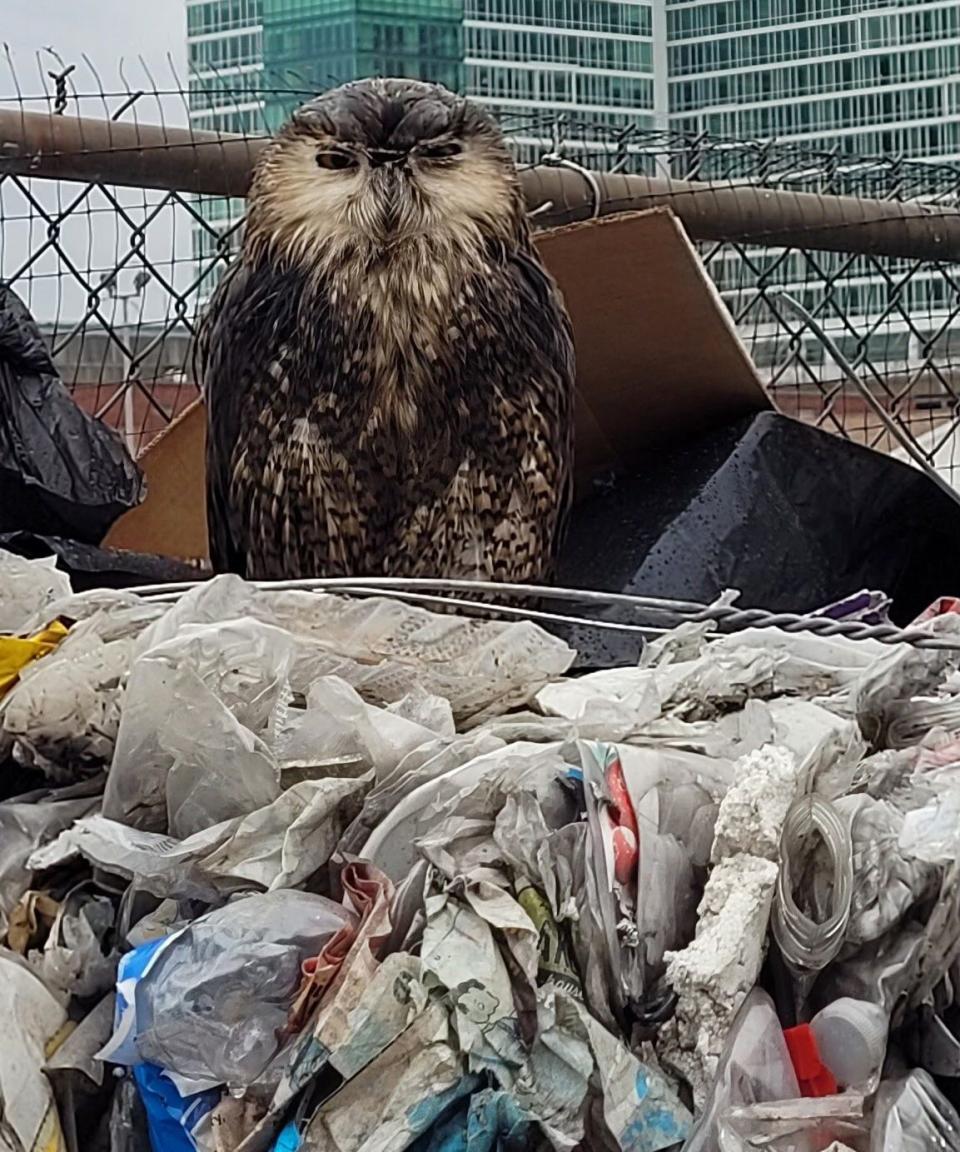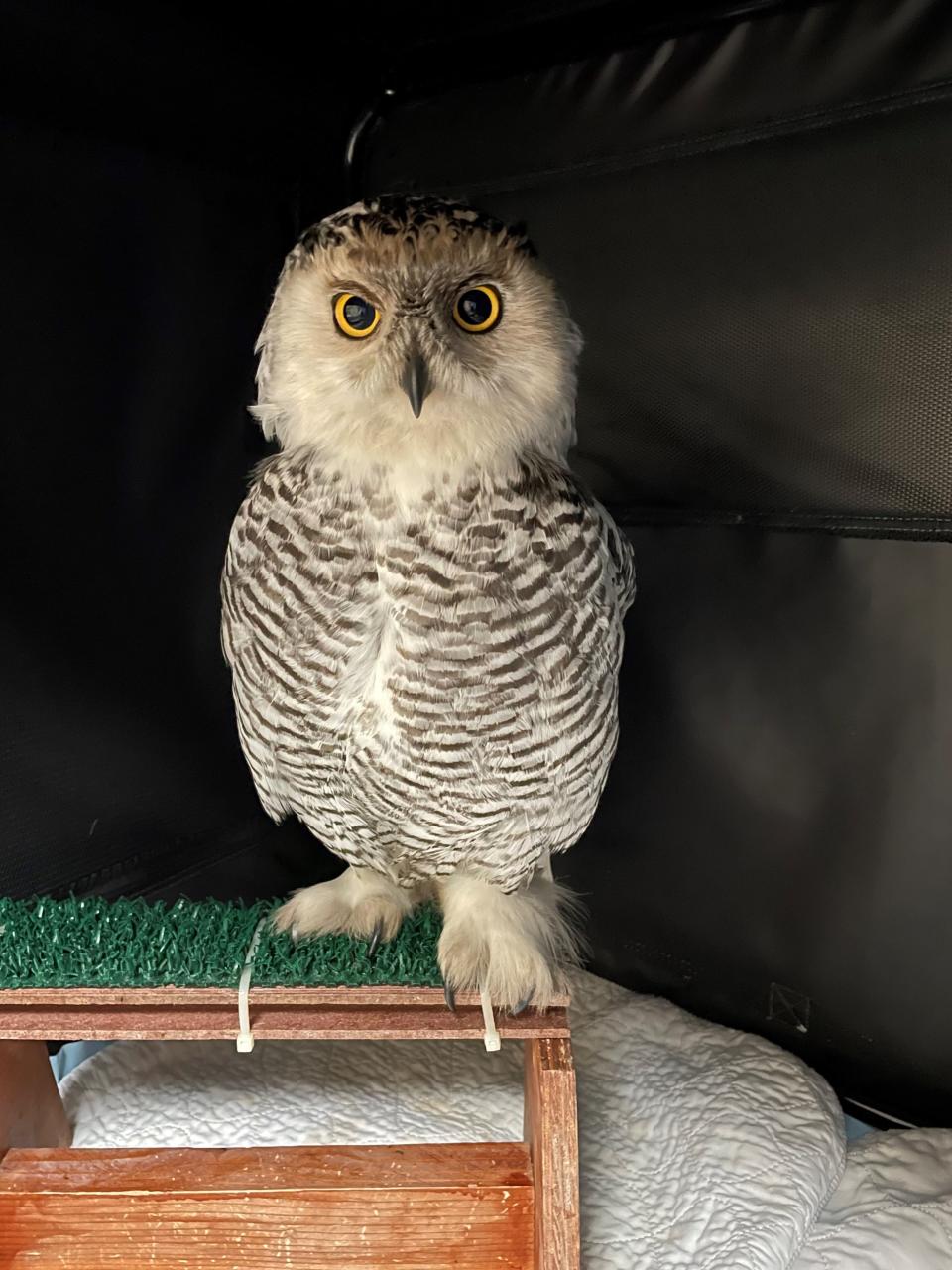Oil-fouled snowy owl found at Milwaukee recycling center is recovering at the Wisconsin Humane Society

Oil doesn't mix with a lot of things.
Add owls to the list.
A snowy owl found last Friday sitting atop a mound of material at a Milwaukee recycling center had its feathers so fouled with diesel oil it couldn't fly.
And its typical bright white coloration was a dingy brown.
"She was very dirty and looked miserable," said Crystal Sharlow-Schaefer, wildlife director at the Wisconsin Humane Society in Milwaukee. "And the oil had soaked through her feathers and pretty much destroyed all their insulation ability."

As a result the bird, already stressed from what was likely more than a 1,000-mile migration from the Arctic, was hypothermic.
To make matters worse, in an effort to clean its feathers the bird ingested some of the oil and another unknown viscous material it picked up.
Fortunately for the owl the staff at the WHS' Wildlife Rehabilitation Center was notified about the bird Friday and a volunteer was able to capture and bring it in for treatment.
More: Smith: Hawk study seeks to unlock secrets of redtails
The initial exam at the center showed the bird to be very weak and in respiratory distress.
Later evaluations also revealed severe abrasions and bruising on its wings, likely from attempts to fly after becoming coated with oil.
"She very likely wasn't going to survive the night out there," Sharlow-Schaefer said.
The bird, determined to be a first-year female, was sedated so it could be meticulously cleaned and dried by staff at the center.
Birds of the far north, snowy owls have layers of feathers for insulation from their heads to their toes.

Each year at least some snowies fly south from their Arctic breeding grounds.
And to the delight of wildlife watchers, some years feature "irruptions" of many hundreds of birds into the United States.
After a slow start this year, a recent surge of snowies has descended on Wisconsin, according to Ryan Brady, Department of Natural Resources conservation biologist.
The agency reported at least 72 owls across 30 Wisconsin counties as of Dec. 1, more than each of the previous three years at that date.
Sightings of the big, white owls have been made in Trempealeau in the west, downtown Madison in the south and in many spots along the Lake Michigan shore, including 12 at a single site on lower Green Bay.
At least two also have been seen this month in Milwaukee.
In 2017, which was regarded as an irruption year, 124 had been documented by the start of December.
More snowies are likely on their way and will tell the tale of this winter, Brady said.
Since the birds spend the vast majority of their lives in wilderness they often show no fear of humans. They also have little to no experience in human-built environments.
Wildlife experts advise people to give the birds space if they encounter them and allow them to hunt without disturbance. The birds feed on mice and other rodents as well as waterfowl.

The snowy that ended up in the Milwaukee recycling center is a good example of the trouble these wild birds from the far north can get into in urban areas, Sharlow-Schaefer said.
"Try to imagine flying around buildings and landing on things you've never encountered before," Sharlow-Schaefer said.
The young, female snowy has responded positively to treatment. As of Tuesday, it was eating well (whole, dead mice), Sharlow-Schaefer said.
And it has begun to show the "appropriate wild animal sass and attitude toward her caretakers, something they’re always grateful to see in wild patients," the WHS said Tuesday in a statement.
The owl's prognosis is guarded, though, since it's still healing from its injuries and gaining strength, according to the WHS.
The wildlife center staff plans to clean the bird once more in the coming days.
"She's on the right trajectory now," Sharlow-Schaefer said. "Fingers crossed, she'll be able to be released sometime this winter and live wild again."
For more on snowy owls, visit dnr.wi.gov and search "snowy owls."
To check on recent bird sightings or report a sighting, visit visit ebird.org/wi/home.
If you see an owl or other wildlife in distress, contact a local licensed wildlife rehabilitator. The DNR has a list at dnr.wi.gov.
In Milwaukee, the WHS Wildlife Rehabilitation Center can be reached at (414) 431-6204.
Our subscribers make this reporting possible. Please consider supporting local journalism by subscribing to the Journal Sentinel at jsonline.com/deal.
DOWNLOAD THE APP: Get the latest news, sports and more
This article originally appeared on Milwaukee Journal Sentinel: Oil-covered snowy owl being treated at Wisconsin Humane Society

